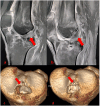Clinical efficacy analysis of arthroscopically assisted orthcord suture fixation in the treatment of tibial intercondylar eminence fractures: a retrospective comparative cohort study
- PMID: 40604106
- PMCID: PMC12222787
- DOI: 10.1038/s41598-025-08979-z
Clinical efficacy analysis of arthroscopically assisted orthcord suture fixation in the treatment of tibial intercondylar eminence fractures: a retrospective comparative cohort study
Abstract
To explore the efficacy of arthroscopically assisted fixation of type II and type III tibial intercondylar eminence fractures with Orthcord sutures. A retrospective analysis was performed on 80 patients with intercondylar eminence fractures admitted to our hospital from April 2020 to March 2023. According to different surgical methods, the patients were divided into special suture fixation group (n = 30), cannulated screw fixation group (n = 24), and wire fixation group (n = 26). The suture group used arthroscopic Orthcord sutures to fix tibial intercondylar eminence fractures, and the cannulated screw group used cannulated compression screws for fixation. Patients in the wire group underwent arthroscopic wire fixation. The basic information of all patients was collected and followed up for 1 year. The Lysholm score and Range of motion of the knee joint and was performed at 3 months and 1 year after surgery. The patients' general data, surgical conditions, operation time, blood loss, hospitalization costs, postoperative recovery (Lysholm score and Range of motion of knee joint and at 3 months and 1 year after surgery) and other data were analyzed by variance analysis. P < 0.05 was considered statistically significant. There was no statistical difference in the general data of all patients. One-year follow-up showed that all patients had achieved bone healing without displacement, or bone malformation. The hospitalization time in the wire group was (11 ± 1.02) days, the screw group was (11.58 ± 1.61) days, and the Orthcord suture group was shortened to (10.03 ± 1.07) days. The differences among the three groups were statistically significant (P < 0.05). At the same time, the cost of Orthcord suture surgery (1310.7 ± 0.29) $ was significantly lower than that of the other two groups (P<0.05). The operation time of the suture group (68.13 ± 1.11 min) was significantly shorter than that of the wire group (76.76 ± 11.57 min) and the screw group (90.62 ± 1.99 min) (P<0.05). In the follow-up, the score of Orthcord suture 3 months after operation (94.07 ± 2.72 points) was better than that of the wire group (90.23 ± 5.23 points) and the screw group (90.37 ± 5.41 points); the difference was statistically significant (P<0.05).Three months after surgery, the range of motion of the knee joint in the Orthcord suture group (124.8°±7.2°) was significantly better than that in the screw group (105.7°±9.3°) and the wire group (112.4°±8.6°) (P<0.05). However, there was no statistically significant difference in the Lysholm score of the three groups of patients 1 year after operation (96.26 ± 1.89, 96.33 ± 2.44, 97.3 ± 1.70) (P>0.05).Similarly, there was no significant difference in the range of knee motion among the three groups of patients 1 year after surgery (135.1°±4.2°), (134.6°±4.8°), and (136.3°±3.5°) (P>0.05).Late fixation fracture and chronic pain complications occurred in both the wire and screw groups, but not in the suture group. (P<0.05). The use of Orthcord sutures in the arthroscopically assisted treatment of intercondylar ridge fractures can shorten the length of hospital stay and surgery, while greatly reducing hospitalization costs. It can achieve better short-term (3 months) recovery effects while avoiding second surgery, and ultimately show no weaker fixation effect than conventional screws and wires when full weight-bearing is restored.
Keywords: Arthroscopy; Eminence fracture; Internal fixation; Orthcord suture.
© 2025. The Author(s).
Conflict of interest statement
Declarations. Competing interests: The authors declare no competing interests. Ethics approval and consent to participate: The studies involving human participants were reviewed and approved by the Ethics Committee of Nanyang Hospital of Traditional Chinese Medicine (Nanyang Orthopedic Hospital; NO.202003). The patients/participants provided written informed consent to participate in this study.
Figures








Similar articles
-
What Are the Recurrence Rates, Complications, and Functional Outcomes After Multiportal Arthroscopic Synovectomy for Patients With Knee Diffuse-type Tenosynovial Giant-cell Tumors?Clin Orthop Relat Res. 2024 Jul 1;482(7):1218-1229. doi: 10.1097/CORR.0000000000002934. Epub 2023 Dec 28. Clin Orthop Relat Res. 2024. PMID: 38153106 Free PMC article.
-
Management of neglected ACL avulsion fractures: a case series and systematic review.Injury. 2017 Aug;48 Suppl 2:S54-S60. doi: 10.1016/S0020-1383(17)30495-3. Injury. 2017. PMID: 28802422
-
[Osteotomy of non-core weight-bearing area of the lateral tibial plateau, reduction, and internal fixation in treatment of tibial plateau fractures involving posterolateral column collapse].Zhongguo Xiu Fu Chong Jian Wai Ke Za Zhi. 2023 Apr 15;37(4):410-416. doi: 10.7507/1002-1892.202301019. Zhongguo Xiu Fu Chong Jian Wai Ke Za Zhi. 2023. PMID: 37070306 Free PMC article. Chinese.
-
Treatment and Management Outcomes of Tibial Eminence Fractures in Pediatric Patients: A Systematic Review.Am J Sports Med. 2014 Jul;42(7):1743-50. doi: 10.1177/0363546513508538. Epub 2013 Nov 20. Am J Sports Med. 2014. PMID: 24256714
-
[Analysis of effectiveness of Holosight robot navigation-assisted percutaneous cannulated screw fixation in treatment of femoral neck fractures].Zhongguo Xiu Fu Chong Jian Wai Ke Za Zhi. 2025 Jun 15;39(6):673-679. doi: 10.7507/1002-1892.202502067. Zhongguo Xiu Fu Chong Jian Wai Ke Za Zhi. 2025. PMID: 40545454 Free PMC article. Chinese.
References
-
- Tuca, M., Bernal, N., Luderowski, E. & Green, D. W. Tibial spine avulsion fractures: treatment update. Curr. Opin. Pediatr.31 (1), 103–111. 10.1097/MOP.0000000000000719 (2019). - PubMed
-
- Rudran, B., Little, C., Wiik, A. & Logishetty, K. Tibial plateau fracture: anatomy, diagnosis and management. Br. J. Hosp. Med. (Lond). 81 (10), 1–9. 10.12968/hmed.2020.0339 (2020). - PubMed
-
- Meyers, M. H. & McKeever, F. M. Fracture of the intercondylar eminence of the tibia. J. Bone Joint Surg. Am.52 (8), 1677–1684 (1970). - PubMed
-
- Zaricznyj, B. Avulsion fracture of the tibial eminence: treatment by open reduction and pinning. J. Bone Joint Surg. Am.59, 1111–1114 (1977). - PubMed
Publication types
MeSH terms
Grants and funding
LinkOut - more resources
Full Text Sources
Medical
Miscellaneous

